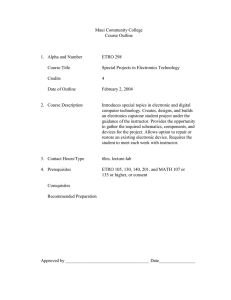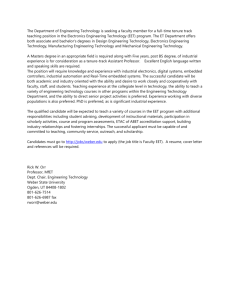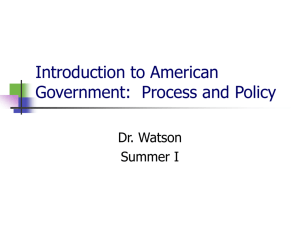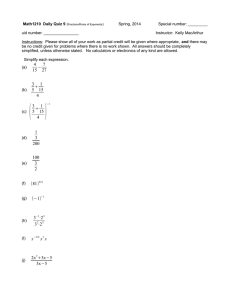Course Syllabus
advertisement
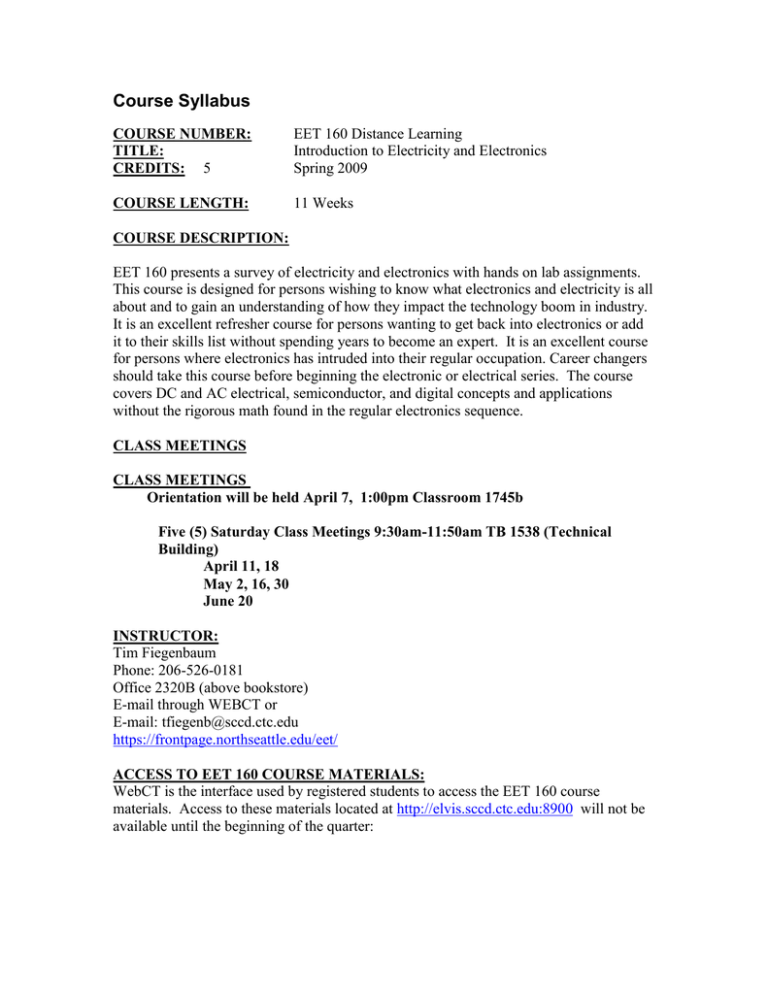
Course Syllabus COURSE NUMBER: TITLE: CREDITS: 5 EET 160 Distance Learning Introduction to Electricity and Electronics Spring 2009 COURSE LENGTH: 11 Weeks COURSE DESCRIPTION: EET 160 presents a survey of electricity and electronics with hands on lab assignments. This course is designed for persons wishing to know what electronics and electricity is all about and to gain an understanding of how they impact the technology boom in industry. It is an excellent refresher course for persons wanting to get back into electronics or add it to their skills list without spending years to become an expert. It is an excellent course for persons where electronics has intruded into their regular occupation. Career changers should take this course before beginning the electronic or electrical series. The course covers DC and AC electrical, semiconductor, and digital concepts and applications without the rigorous math found in the regular electronics sequence. CLASS MEETINGS CLASS MEETINGS Orientation will be held April 7, 1:00pm Classroom 1745b Five (5) Saturday Class Meetings 9:30am-11:50am TB 1538 (Technical Building) April 11, 18 May 2, 16, 30 June 20 INSTRUCTOR: Tim Fiegenbaum Phone: 206-526-0181 Office 2320B (above bookstore) E-mail through WEBCT or E-mail: tfiegenb@sccd.ctc.edu https://frontpage.northseattle.edu/eet/ ACCESS TO EET 160 COURSE MATERIALS: WebCT is the interface used by registered students to access the EET 160 course materials. Access to these materials located at http://elvis.sccd.ctc.edu:8900 will not be available until the beginning of the quarter: DISTANCE LEARNING: Distance Learning Home Page OFFICE HOURS: Mon / Wed 4:30pm-6:00pm Saturday after scheduled lab days REQUIRED TEXTS: Textbook: Electronics for Computer Technology, David Terrell, ISBN 0-7668-3872-2 Simulation Software: MultiSim is provided with the textbook Lab Manual: Lab Manual to Accompany Electronics for Computer Technology, Ernest Arney, ISBN 0-7668-3873-0 These books may be purchased at the NSCC book store or ordered on line. If students elect to purchase a used textbook, it is imperative that the CD be included with the text. COURSE OUTCOMES/LEARNING OBJECTIVES At the completion of this course you should be able to: 1. Identify series and parallel circuits, take measurements of electrical values, identify open and shorted circuit conditions, calculate using Ohm’s law, and read an electrical diagram. 2. Identify major test instruments, electrical and electronics components. 3. Take measurements using the multimeter and oscilloscope; operate a function generator and power supply. 4. Construct simple experimental circuits. 5. Identify electronic terms, components, and devices. 6. Understand concepts of resistance, current, voltage, power, frequency, reactance, and electro-magnetism. 7. Identify logic circuits, gates and memory circuits. Read logic diagrams. 8. Differentiate between computer operations and microprocessor systems. COURSE OUTLINE Topical Outline and/or Major Divisions: I. Overview of Electronics/Electrical programs at NSCC. II. Historical Events and Technological Milestones III. Vertical and Horizontal Spread of Electronics/Electrical Industries A. Military B. Heavy industry, energy and process control. C. Communications and telecommunications D. Medical & Laboratory instruments. E. Consumer and educational products F. Office and business G. Space and aerospace IV. V. VI. VIII. IX. X. H. Scientific and research Electricity Production and Supply A. Methods of electricity generation. 1. Electro-magnetic 2. Piezoelectric, photo-electric 3. Chemical B. Ohm’s law and electrical units of measure C. Power, work and energy D. Magnetism, Electro-magnetism Test Instruments. A. Multimeter 1. Analog 2. Digital B. Power supply and function generator C. Oscilloscope Alternating Current A. AC voltage and sine wave 1. Waveforms 2. Frequency B. Electromagnetic induction C. Generators and motor basics D. Transistor principles and applications 1. Bipolar 2. JFET 3. MOSFET E. Biasing and characteristics F. Packaging Electronic Circuits A. Amplifiers B. Oscillators C. Linear vs. non-linear operation D. Transistor circuit configurations E. Integrated circuits and op amps Digital Electronics A. Numbering systems B. Code C. Gates and truth tables D. Combinational logic E. Boolean algebra F. Flip-flops and truth tables 1. Counters 2. Registers 3. Detectors, decoders, encoders G. Digital displays Computers and microprocessors A. Architecture B. Computer basics C. Peripherals D. Software and programming READING ASSIGNMENTS & APPROXIMATE COURSE SCHEDULE * Text: Electronics for Computer Technology Assignments: The Calendar in Web CT addresses due dates Assignment 1 5 days Chapter 1 Assignment 2 5 days Chapter 2 Assignment 3 7 days Chapter 3 Assignment 4 7 days Chapter 4 Assignment 5 7 days Chapter 5 Assignment 6 7 days Chapter 6 Assignment 7 7 days Chapter 7 Assignment 8 7 days Chapter 8 Assignment 9 7 days Chapter 9 Assignment 10 7 days Chapter 10 Assignment 11 7 days Chapter 11 Assignment 12 Extra Credit Chapters 15-16 * Schedule is subject to change at discretion of instructor PROCESS: There will be extensive reading (500-600 pages), but with a focus on concepts and terminology, not rote memorization. Lectures will be delivered online as MP3s. They can be accessed through your student WEBCT account. For maximum viewing size pixel display settings should be 800 X 600. In class meetings are scheduled every two weeks on Saturdays. During this time students will build circuits with real components and take the midterm and final exams. The scheduled dates are on the calendar in WebCT. For on campus students open lab hours can be arranged during the week in the electronics lab. Communication between students and the instructor will be primarily through the email system built into WebCT. If there is a critical need to contact the instructor immediately use his primary e-mail address or call. The instructor will lead discussions on the discussion page at the WebCt homepage. Participation in this discussion will make up 10% of the students grade. Students are encouraged to make an entry in response to discussion questions the week the questions are posted. At the end of the quarter the instructor will review discussion participation and assign a discussion score. Students are encouraged to post their own discussion questions or comments as long as they pertain to the course. There will be quizzes at the end of each chapter in an online format. The quizzes will be taken through WebCT and address the objectives of each chapter. These quizzes are open book will make up 10% of your grade. There will be time limits on how long you have to complete the quiz, though they are usually quite long. These quizzes should be taken as you complete the chapter assignments. They can be taken up to 4 times, but the grade will be recorded from the first try. Be sure to take the practice quiz before you take a real test so you understand how to take the online WebCT tests. All of the quizzes for the entire course are posted at WebCT. It is recommended to not take the chapter quizzes until you have completed the associated reading, homework, labs and lectures. If you complete the quizzes on the schedule laid out in the WebCT calendar you will receive a 10 point bonus for each quiz. There will be graded lab assignments. Labs will be completed and torn out of the lab book. The lab book pages are perforated for so they can easily be torn out. They will be turned in during the Saturday meetings or mailed to the instructor. If you miss the Saturday session they must be mailed to the instructor and received no later than 6 days after the missed session. They should be mailed to Tim Fiegenbaum, 9600 College Way North, North Seattle Community College, Seattle WA. 98103. If you prefer to drop them off, my office is room number 2320B in the IB building (above the bookstore). When labs are turned in please group them according to the assignment they are associated with. For example Assignment 3 has 5 labs associated with it. Please turn in all 5 together with a cover sheet identifying them as Assignment 3. Assignment 1 has no labs and assignment 2 has only one lab. Cover sheets will be provided. Labs that are turned in according to the WEBCT calendar schedule will receive a 10 point bonus for each assignment Homework will consist of completing the odd numbered questions at the end of each chapter in the text book. The answers to the odd numbered questions are in the back of the book. These questions will not be turned in, but it is imperative that you do them since the quiz questions will be based directly on this content. In order to use the computers in the electronics lab, and take the midterm and final each student will need a Net ID account. To sign up go to the following link: https://netid.northseattle.edu/ncreate.php Student Supplies: Each student will need access to a computer with a high speed internet connection (DSL, CABLE or, Satellite). This will be necessary to view the curriculum and take the online quizzes. If a student is using a dialup modem, contact the instructor to obtain the curriculum on CD. A basic scientific calculator will be necessary for this course. The calculator must be able to perform sin functions (sin, tan, cos), square root, exponents, etc. Casio, Sharp and Texan Instrument make a number of calculators for under $20 that should be more than adequate. For example: http://www.bestbuy.com/site/olspage.jsp?skuId=3667213&st=calculator&lp=6&type=pr oduct&cp=1&id=1051826275517 . Other calculators that perform the same functions will be fine. A graphing calculator would be recommended for advanced courses, but will not be necessary for EET 160. Throughout this course a calculator (Calc98) will be used which is available as a free download http://www.calculator.org/download.html. Though this calculator will be sufficient for the math in this class it is recommend that students purchase a hand held calculator. STUDENT EVALUATION METHOD Grades will be based on the following: Category Labs Chapter Quizzes Participation Mid Term Exam Final Exam Approx. # 40 11 (chap 1-11) Discussions Extra Credit: Assignment 12 Percentage of Grade 20% 10% 10% 30% 30% 100.0% Total Chapter 15-16 5% Bonus Grade Assignment 96 - 100 % 95 94 93 92 91 90 89 88 87 86 85 84 83 82 81 80 79 78 77 3.4 3.3 3.2 3.1 3.0 2.9 2.8 2.7 2.6 2.5 2.4 2.3 2.2 2.1 4.0 3.9 3.8 3.7 3.6 3.5 76 75 74 73 72 71 70 69 68 67 66 65 64 63 62 2.0 1.9 1.8 1.7 1.6 1.5 1.4 1.3 1.2 1.1 1.0 .9 .8 .7 .0 NSCC Grading System: See Student Handbook http://www.northseattle.edu/info/pub/handbook.htm ACCOMMODATIONS Any student with a documented learning disability (i.e. physical, learning, psychiatric, vision, hearing) who needs to arrange reasonable accommodations is requested to contact the Educational Access Center, and the instructor, at the beginning of the quarter. Survey Course Please keep in mind that this is a survey course. We will touch upon subject matter that would normally be addressed in 6-8 courses in the regular EET curriculum. For that reason we will not be going into the detail that would accompany the regular course offerings. Though grasping all the detail is a desirable pursuit, please do not let it come at the cost of getting behind. Holidays: Memorial Day May 25 Monday
